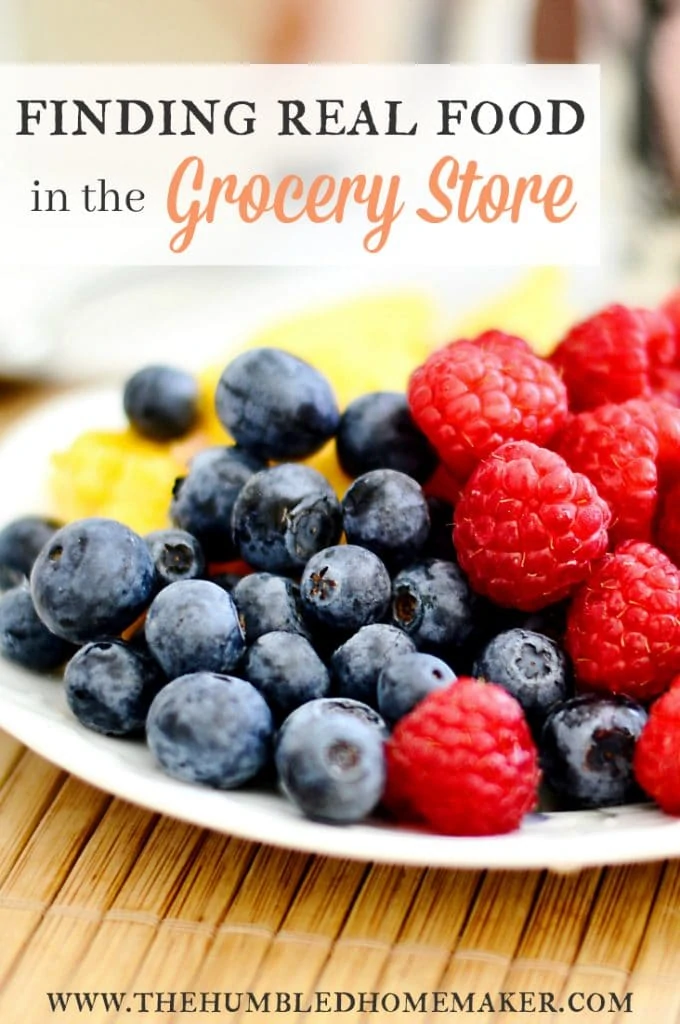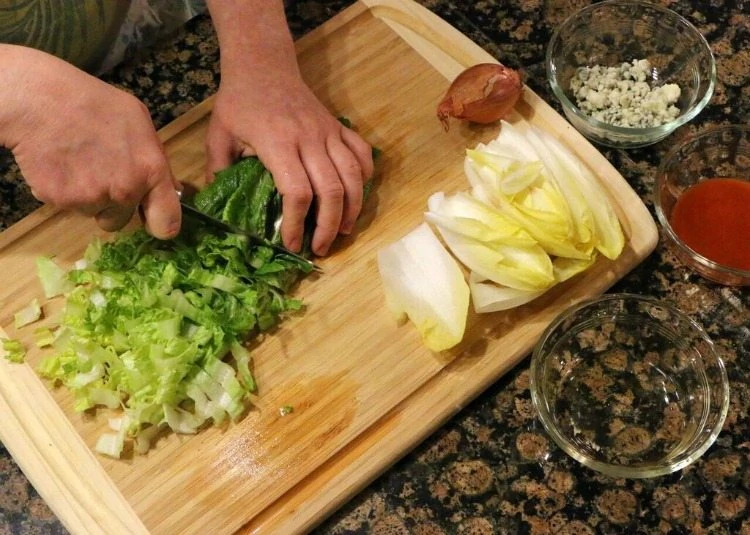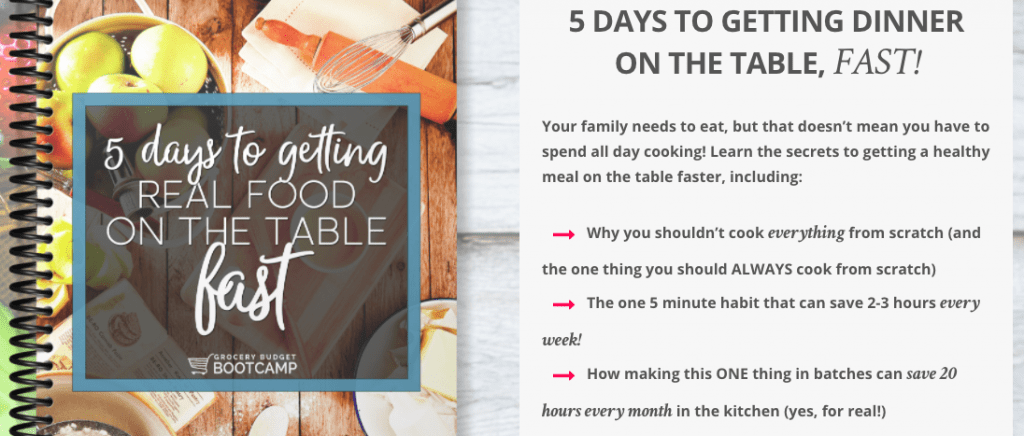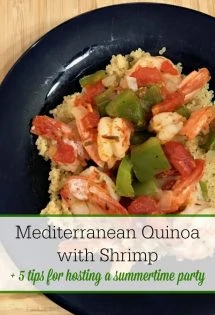Starting your real food journey doesn’t have to mean shopping at new stores. Finding real food in your grocery store is possible.

One of the biggest eye-openers for me when I first started my real food journey was that so many real foodies shop directly from the farmer or purchase food online.
I was accustomed to using coupons for processed foods at mainstream grocery chains–or buying food for rock-bottom prices at my still-beloved Aldi.
And, truth be told, although we’ve taken baby steps like planting our own garden, purchasing some items online, and buying a very small amount of meat and eggs from a local farmer, the majority of our food still comes from a “real” brick-and-mortar grocery store.
If you are brand new to real food, then I imagine the thought of locally sourcing your food is exciting and ideal–but perhaps a little overwhelming at first.
So let’s back up a bit and take a tour of the local grocery store you frequent. I’ll walk you through each section of the store and virtually point out what to buy, what to leave on the shelf and where to compromise.
A Virtual “Tour” of Your Grocery Store
Produce
If you are cooking real food, this will be one of the sections where you spend most of your time.
What to Buy: Aim to purchase as much organic and/or locally-grown produce as your budget allows–if your store carries it. (Many don’t.)
What to Leave: Don’t buy from the dirty dozen list or conventional corn, summer squash and zucchini, or Hawaiian papaya, which are largely genetically modified.
Where to Compromise: Focus on purchasing non-organic items from the clean 15 list. If there’s an item on the dirty dozen that you absolutely cannot live without, and you cannot find the organic version, give yourself grace and buy it every once in a while–but commit to cut back on your consumption of it.
Dairy
What to Buy: Aim to purchase full fat, organic dairy (raw, if, by chance, you’re in a state that sells it in a grocery store!). If you cannot find organic dairy, look for dairy made from grassfed cows (like Kerrygold Cheese, which my local BJ’s carries). (See Diana’s post for further explanation about dairy options beyond the grocery store!)
What to Leave: Absolutely, positively leave any processed cheeses (i.e. Velveeta, American cheese slices, etc.) on the shelf. Also leave full-fat dairy made from cows given hormones.
Where to Compromise: Purchase dairy that is made from cows not treated with the rBGH growth hormone. (It will usually say it somewhere on the package.)
If you cannot find any hormone-free cheese, opt for regular (non-processed) cheeses that are natural in color (white). The back of the package will say whether or not color has been added.
If you cannot find any hormone-free milk, I would personally ditch the dairy milk and choose coconut, almond, or even rice milk instead. (But stay far away from soy milk!)
Eggs
What to Buy: Aim to purchase organic eggs from free-range/cage-free/certified humanely-raised chickens (locally raised if your store happens to carry them).
What to Leave: Ditch the egg replacers (unless we’re talking flax meal or chia seed!). What’s in those things any way?!
Where to Compromise: If organic eggs are not available, at least look for cage-free/free-range eggs (although this label can be sketchy and not necessarily indicate chickens who roam in the grass and scratch in the dirt for worms). Next, opt for conventional eggs. Sure, they may not be organic, but some eggs are better than no eggs.
Meat
What to Buy: Aim to purchase organic meat and wild-caught seafood.
What to Leave: It’s time to give up the processed chicken nuggets, fish sticks, Spam and other pseudo meats.
Where to Compromise: If organic meat is not an option, first look for meats with the label “hormone/antibiotic-free.” If you cannot find any meat that fits that bill, purchase conventional–yet unprocessed–meats and farm-raised fish, but commit to lowering your meat consumption and supplementing with other sources of protein, such as beans. (Kitchen Stewardship’s The Everything Beans Book is a good place to start for meatless meals recipes!).
Also, try to vary your meats so you aren’t always eating one certain type that may be overexposing your family to certain antibiotics, etc.
Image by stevendepolo
Frozen Foods
What to Buy: Aim to purchase frozen organic produce and meats that contain no additives, seasonings, etc.
What to Leave: Pass over the pre-made, processed meals and pre-seasoned veggies, etc.
Where to Compromise: Purchase conventional frozen foods that are whole and not processed.
Beans/Legumes
What to Buy: Aim to purchase organic dried beans and legumes.
What to Leave: Opt out of the packaged beans and legumes (whether canned or frozen) that have been pre-seasoned.
Where to Compromise: Purchase conventional dried beans, or give yourself grace during busy seasons and buy canned beans–even though most canned goods contain BPA.
Condiments
What to Buy: Don’t buy them. Make your own.
What to Leave: Any condiments that list high fructose corn syrup, soy, or any of these ingredients (or anything you can’t pronounce) should be left on the shelf.
Where to Compromise: Purchase organic versions and/or versions that contain 5 ingredients or less–and all ingredients that you can recognize.
5 Days to Getting Dinner on the Table, FAST!
For more help with getting healthy food on the table, check out the free training 5 Days to Getting Dinner on the Table Fast.
It includes (all free):
- 5 day plan to start getting real food on the table without stressing
- Worksheets designed to help you accomplish your meal plans
- Learning how to cook from scratch without taking too much time
- How to make real food fit into your busy schedule
- 30-minute meal plan
- A breakfast cookbook
Sweeteners
What to Buy: Raw, unfiltered honey, grade B maple syrup, stevia and blackstrap molasses will be your best options for sweeteners that you may find in your local grocery store–along with some of the others mentioned in this post.
What to Leave: Say goodbye to white sugar–especially white sugar made from sugar beets, which are largely GMO. But if your hubby absolutely must have his sweet tea with white sugar, don’t cause a fuss. Let him. Oh, and leave behind the brown sugar, Karo syrup, agave nectar, and ANY artificial sweeteners as well.
Where to Compromise: If your store does not contain any of the above “best” options, look for regular honey, but try to get a version that has all been made in the same country. Make sure it’s 100% pure honey and doesn’t contain high fructose syrup.
Next, look for grade A 100% pure maple syrup (I get mine at Aldi.) or 100% pure molasses. Lastly, try to find white sugar made from sugar cane instead of sugar beets.
And if plain white sugar is all you can find, then it’s better than artificial sweeteners–any day.

Baking Supplies
What to Buy: Aim to purchase whole wheat or white whole wheat flour, one of the sweeteners listed above, and coconut (most Wal-marts carry it!), olive or grapeseed oils.
What to Leave: Don’t give white flour a second glance–and it’s time to put canola and vegetable oils away as well. And, of course, don’t even enter the aisle that carries pre-made baked goods!
Where to Compromise: Most store should have whole wheat flour and at least olive oil. You shouldn’t have to compromise as much here.
Beverages
One word: Water. Save the money you would be spending on soft drinks and juices and one day you can buy a Berkey water filter! (See “Dairy” for milk options.)
Snacks
What to Buy: Aim to purchase the supplies to make your own snacks. (Yes, you really can make healthy snacks “to go”!)
What to Leave: Skip the inner, snack aisles altogether! There is not much good there!
Where to Compromise: Opt for snack foods that contain 5 “real food” ingredients or less. At our house that includes veggie chips and rice cakes.
Canned/Boxed Foods
What to Buy: Don’t. Buy the ingredients and make your own “boxed” meals that are better than a box.
What to Leave: Um, just about everything!
Where to Compromise: OK, well, you could buy canned tomatoes. Those at least retain some nutritional value. And I also buy pasta in a package. Opt for whole wheat or brown rice, quinoa or GMO-free corn pasta if you are gluten free.
So what’s the bottom line when it comes to real food grocery shopping?
If you remember nothing else about this post, I want you to remember this: Shop the outer perimeter of the grocery store and avoid the inner aisles. The outside is where the whole foods are stocked. And read each and every food label very closely!
Further Reading
Did you know that Stephanie wrote an entire series on this topic in the early days of Keeper of the Home? There are some great little nuggets to dig out of the following posts:
The Secrets of Where Real Foodies Buy Their Ingredients
A Real Foodie’s Pantry & Cupboards
Making the Best of the Regular Grocery Store
Inner Aisles: Making the Best of the Regular Grocery Store
Breads and Pasta: Making the Best of the Regular Grocery Store
Meats: Making the Best of the Regular Grocery Store
Produce and Seafood: Making the Best of the Regular Grocery Store
Dairy: Making the Best of the Regular Grocery Store
How to Buy Meat, Poultry and Eggs in a Regular Grocery Store
Real Food Begins with the Right Ingredients
Finding High Quality Sources for the Real Food Diet
Other posts in the series:
Real Food Made Simple: A Beginner’s Guide to Eating Better
Cutting Your Kitchen Prep Time in Half — Or More!
Confessions of a Formerly Picky Eater
The Grain Controversy: Should We Eat Them or Not?
Second Steps Towards Eating Real Foods: Switching Your Food Sources
Sweeteners: How They Affect You, Which Ones are Best, and How to Use Them
Simple Steps to Begin Cooking Homemade: Pantry Staples
5 Strategies to Help Your Husband and Kids Transition to Real Food
20 Easy Real Food Switches and Substitutions {with Free Printable Chart}
First Steps to Eating for Fertility
Keeping Costs Down in a Real Food Kitchen
5 Ways to Get More Fruits & Veggies into your Diet
Food Is Not Cheap: 4 Steps to Budgeting in Real Food
Simple Steps to Begin Cooking Homemade: Baked Goods
Simple Roast Chicken (And Fabulous Side Dish Recipes!)
17 Homemade Spice Mixes {with Recipes & Why You Should Use Them!}
5 Ways Green Living and Real Food are Connected
Simple Steps to Begin Cooking Homemade: Soups, Sauces, and Simple Dinners
Do you shop for real food in a grocery store? What real foods do you buy at your grocery store?
*Disclosure: This post contains affiliate links.












Leave a Comment